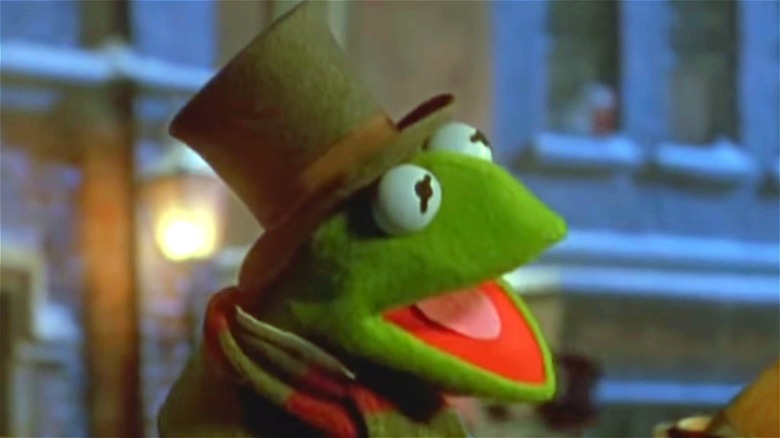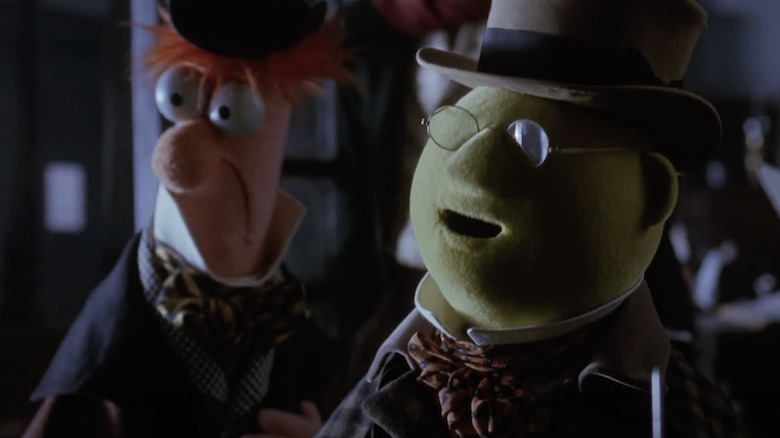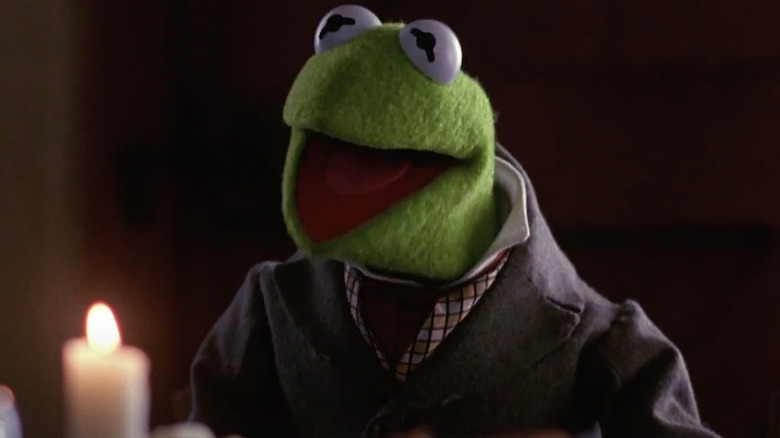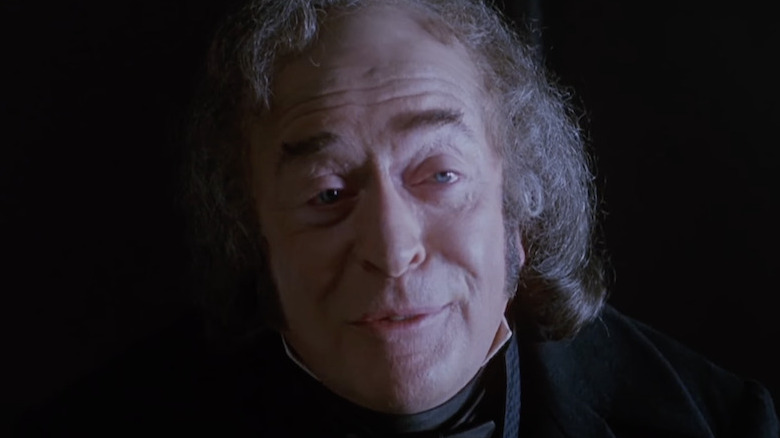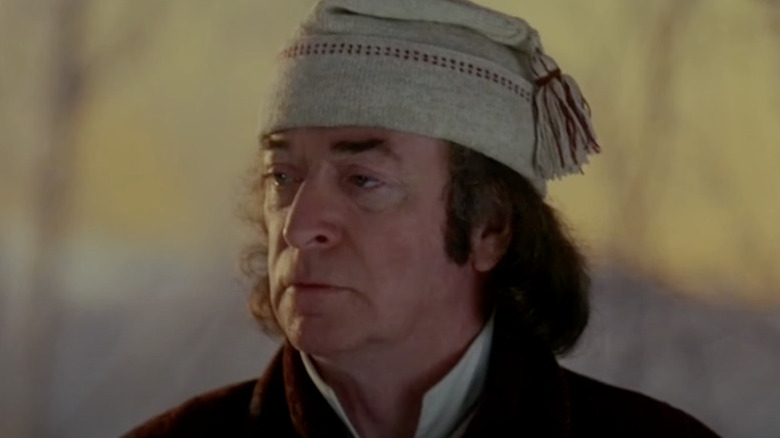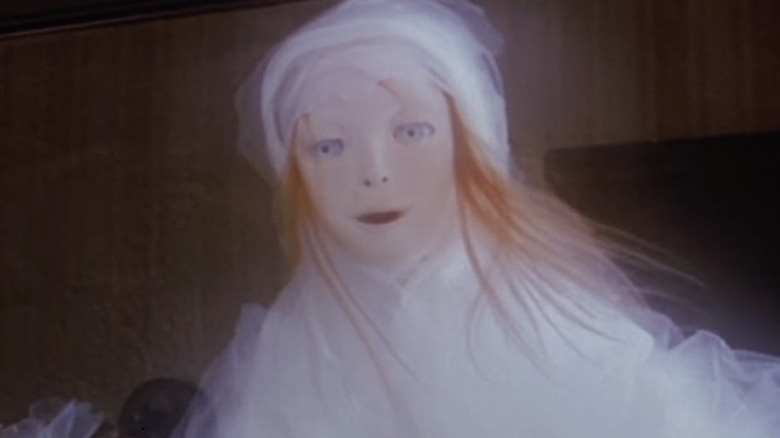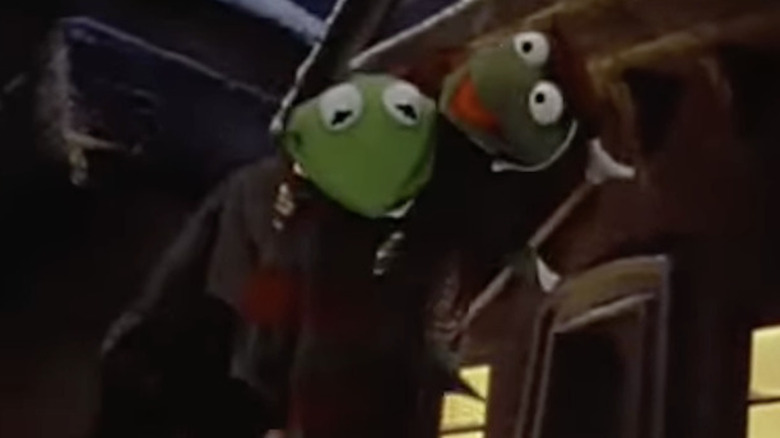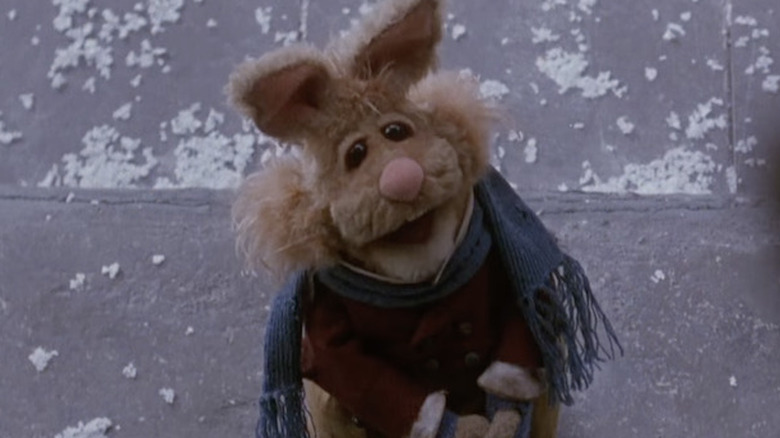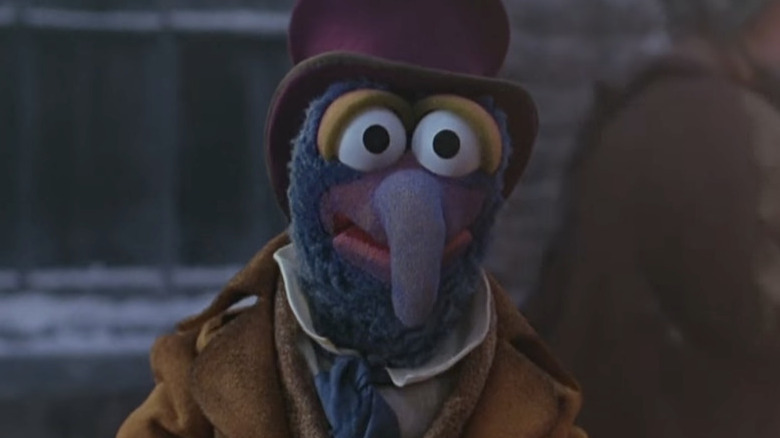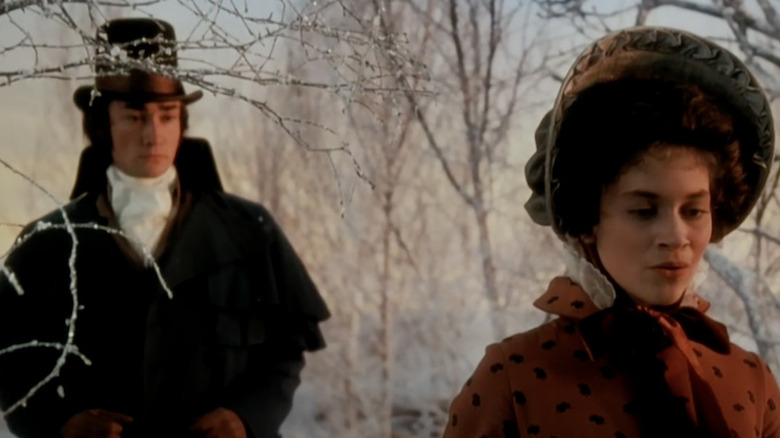The Untold Truth Of The Muppet Christmas Carol
In 1992, Jim Henson's family-friendly gang of frenetic, subversive, and complicated puppets — the internationally adored and renowned Muppets of "The Muppet Show" — returned from an eight-year big-screen hiatus with one of the organization's most ambitious and moving projects of all time: an adaptation of Charles Dickens' 19th century towering classic of holiday literature, "A Christmas Carol." Starring Michael Caine as Ebenezer Scrooge, a real Christmas-hating 19th century English humbug who learns the error of his ways and the effects of a nastily lived life, "The Muppet Christmas Carol" became a perennial must-watch-in-December movie for millions because of the indelible and unforgettable appearances by those Muppets. Kermit plays Bob Crochet, Miss Piggy, his wife, Emily, Robin the Frog as deathly ill Tiny Tim, "Muppet Show" hecklers Statler and Waldorf portray the ghostly Marley brothers, and Gonzo narrates as Dickens himself.
"The Muppet Christmas Carol" warms hearts and engenders laughs, nostalgia, and tears, but it was a difficult movie to make, technically and emotionally. Here's a look behind the scenes — and at the lasting impact of — "The Muppet Christmas Carol."
It was supposed to be a TV special
More than a half dozen made-for-TV specials celebrating Christmas and featuring various groups and iterations of Jim Henson's Muppets have aired since 1970, and "The Muppet Christmas Carol" nearly ranked among small-screen holiday favorites like "Emmet Otter's Jug-Band Christmas" and "A Muppets Christmas: Letters to Santa." By the early 1990s, it had been a long time since the Muppets had appeared in a feature film, the last being the middlingly financially successful "The Muppets Take Manhattan" back in 1984. For the Muppets to make a holiday movie, it made sense to go small-screen rather than big, and that's the approach the brand's business representative took.
"Our agent, Bill Haber, said to me: 'Christmas Carol' is the greatest story of all time, you should do that," second-generation Muppet creative Brian Henson recalled to The Guardian in 2015. "While I was thinking about it, he called me back and said: 'I've sold it to the ABC TV channel.'" His own hand and those of others forced, Henson got to work adapting and envisioning Charles Dickens' most famous work for television, before realizing that the project would be more suited for the cinema.
It marked the first time someone besides Jim Henson played Kermit the Frog
"The Muppet Christmas Carol" was a watershed project for the studio and franchise founded by puppet-master Jim Henson. Not only was the film the first one ever directed by Henson's son, Brian Henson, it was the first movie produced after the death of Jim Henson at age 53 in 1990. (The Muppet crew lost another vital member in Richard Hunt, who started working with Henson back in the early 1970s, operating and voicing characters including Scooter, Beaker, and Janice; he died in early 1992, when "Christmas Carol" was in production.)
The film bears a dedication to both Hunt and Henson, who was succeeded in his portrayal of Kermit the Frog (Bob Cratchit) by veteran Muppet performer Steve Whitmire. He was extremely nervous about filling Henson's shoes, but while sleeping the day before he was slated to start work on the movie, he found the affirmation he needed. He dreamt that he met Henson at a desk in a hotel lobby. "I said, 'Listen, I have to tell you, I'm really nervous about doing Kermit tomorrow. I've got to do this voice for the first time, really, and I'm real nervous,'" Whitmire recalled to Muppet Central. "He stopped, and there was a thoughtful gesture Jim would do where he would take both of his index fingers and put them under his chin, and he did that and thought and he said, 'It will pass.' Which is exactly what Jim would have said."
Michael Caine approached The Muppet Christmas Carol as if it were a very serious film
The primary character in Charles Dickens' "A Christmas Carol" is the sour, dour, and positively wicked Ebenezer Scrooge, portrayed in "The Muppet Christmas Carol" by Michael Caine, a two-time Academy Award winner and one of the most celebrated actors of his generation. While "The Muppet Christmas Carol" is at its heart a comedic parody movie aimed at an audience of children and populated by puppets, Caine treated the project with the utmost seriousness.
"When I first said to people that I was going to do a movie with the Muppets they found that kind of silly," Caine told The List. "As it turned out, I played it absolutely straight, as though I was with the National Theatre or the Royal Shakespeare Company." To play Scrooge in such a way required preparation, and Caine got into the right frame of mind by studying real-life, headline-making villains of the late 1980s and early 1990s. "My basic role models came from watching CNN and seeing the trials and tribulations of all the Wall Street cheats and embezzlers," he said. "I thought they represented a very good picture of meanness and greed."
Michael Caine beat out some stiff competition for the role of Scrooge
While Michael Caine is an actor of impressive stature, and seasoned enough to take on the showy and complex role of cruel miser-turned-Christmas-lover Ebenezer Scrooge in "The Muppet Christmas Carol," he wasn't the first actor that the film's producers had in mind or seriously considered.
According to The Independent, there was Ron Moody (who had Charles Dickens adaptation experience, nominated for an Oscar in 1969 for portraying Fagin in "Oliver!", the musical version of "Oliver Twist"). British actor David Hemmings, best known for '60s classics like "Blow-Up," "Camelot," and "Barbarella" was also up for Scrooge, as was David Warner, best known to American audiences for his character work in "TRON," "Titanic," and "Star Trek VI: The Undiscovered Country." Stand-up comedian and sometime actor Bob Carlin was Caine's most serious competitor for the role, and producers went so far as to film some screen tests before going with their final choice.
The Christmas ghosts proved tough to film correctly
Computer-generated imagery, or CGI, technology is commonplace in 21st century film, and it was used to render realistic-looking effects in '90s movies like "Jurassic Park," "Titanic," and "The Matrix." "The Muppet Christmas Carol" was produced in 1992, just before the advent of CGI, so all of the film's many effects shots, to bring to life the spooky ghosts of Charles Dickens' source novel, had to be made by elaborate, practical means, and with puppets to boot. According to the DVD commentary track (via Film School Rejects), filmmakers initially planned to make it look like The Ghost of Christmas Past puppet was hypnotically floating by recording it submerged in a tank of baby oil. The amount of oil required was so cost prohibitive, however, so the crew used water instead. The ghost's robes did flow, but the water caused a caustic reaction with the glues and dyes used in the puppet.
Limitations also led Brian Henson to shrink down to size the Ghost of Christmas Present, which the director wanted to be extra large. Instead, he opted for a huge face, which he made by filming a regular-sized Muppet against a blue-screen (to add in backgrounds later), and in reverse.
The Muppet Christmas Carol involved some of the hardest shots in Muppet history
According to director Brian Henson on the DVD commentary track (via Film School Rejects) for "The Muppet Christmas Carol," this 1992 movie about the simple joys of the holidays includes some sequences that were among the hardest the franchise's experienced filmmakers and puppeteers ever committed to celluloid.
One of those is a simple bit of screen business, in which Kermit, as Bob Cratchit, blows out a candle. But Muppets are puppets, and they don't breathe real air that could extinguish a flame. To put out the candle, a crew member had to fire an air gun at the flame at the precise moment that Kermit's operator, Steve Whitmire, contorted the puppet's mouth into a blowing position.
Another sequence involved almost a dozen veteran Muppet performers. The production number "'Tis the Season" was indeed a production, with the camera catching a full-figure of Kermit, legs and all, singing while walking down the street of 19th century London with Tiny Tim (Robin the Frog) perched on his shoulder. To make it appear that the puppet was walking, he was filmed moving along a spinning drum obscured with fake snow. Some puppeteers worked on that while others worked on the other limbs and the mouths of Kermit and Robin — 10 in all. All of that was captured against a blue screen, so effects artists could later, and painstakingly, superimpose Victorian London urban scenery.
The Muppet Christmas Carol is full of inside jokes
As most individuals who interact with Ebenezer Scrooge in any version of "A Christmas Carol" encounter his wrath, in "The Muppet Christmas Carol," it's Bean Bunny, a rabbit Muppet who comically suffers the brunt of Scrooge's rage, getting pummeled by both a wreath and a turkey. What did poor Bean Bunny ever do to deserve such hostility? Nothing — Muppet makers invented him solely to burden him with abuse. According to the "Muppet Christmas Carol" DVD commentary track (via Film School Rejects), Bean was conceived as a character so over-the-top sweet and cute that viewers couldn't help but loathe him. That hatred translated into good-natured aggression within the Muppet camp, and that led to the nature of his appearance in "The Muppet Christmas Carol."
Other inside-Muppets only moments in the film: When Gonzo tells Rizzo he is "such an idiot" for climbing over a gate instead of walking through it, that's a verbatim reference to a ribbing Gonzo puppeteer Dave Goelz delivered to Rizzo's operator, Steve Whitmire. And according to director Brian Henson on the commentary track, the portrayal of the Cratchit daughters is a subtle sendup by Goelz and Whitmire of how Muppet performer Frank Oz portrays Miss Piggy. And the shooting star in the sky in "One More Sleep 'til Christmas" is a nod to Jim Henson — it's a replica of a similar shot from "The Muppet Movie."
The Muppet Christmas Carol is an extremely faithful adaptation
As one of the most definitive and enduring Christmas stories, Charles Dickens' "A Christmas Story," in which greedy, stingy, and cruel Victorian-era English miser Ebenezer Scrooge is scared into a life of goodness after being visited by ghosts representing Christmases past, present, and future, has been adapted for the screen more than 100 times, notably a well-received 1951 film version, a 1999 made-for-TV take starring Patrick Stewart, the animated Disney production "Mickey's Christmas Carol," and 1992's "The Muppet Christmas Carol." But out of all of those, the one that's the most faithful is, surprisingly, the adaptation with all of the puppeteers playing Muppets playing characters created by Dickens in 1843.
Initially, the plan for "The Muppet Christmas Carol" was for the film to be a much zanier comedy. "The Muppets are famous for questioning the status quo, and anti-establishment irreverence, so we took that and pointed it at Charles Dickens," director Brian Henson told The Guardian. "We were going to do a romping parody. Then we stopped and reconsidered." The reason: Henson realized that in the process of converting prose to screenplay format, Dickens' unique, descriptive, and acclaimed language got lost. Henson and his fellow creatives came up with the idea of putting Dickens himself into "A Christmas Carol," casting Gonzo as the author. "We made him this omniscient storyteller, with Rizzo his pain-in-the-neck sidekick," Henson said, adding that "95 percent" of Gonzo's dialogue was taken straight from the original text.
Some songs are missing from The Muppet Christmas Carol
Like most other Muppet movies, "The Muppet Christmas Carol" is technically a musical, with the characters breaking out into song, dance, and production numbers whenever the dialogue written by Charles Dickens or screenwriters just doesn't do their emotions justice. Songwriter Paul Williams (nominated for the Best Song Oscar back in 1980 for co-writing "The Rainbow Connection" from "The Muppet Movie") returned to the Muppets franchise to write a dozen songs for "The Muppet Christmas Carol." But Williams wrote even more tunes — "Room in Your Heart" and "Chairman of the Board" appear on the official film soundtrack album but are not heard in the movie itself, recorded but ultimately scuttled from the movie, as songs can slow down the plot and add to the running time.
Williams' "When Love is Gone" made it to the album but not the theatrical version. According to director Brian Henson in The Big Issue, distributor Disney "wanted the movie shorter" for its first run, agreeing to put it back in when the film hit VHS. But then, after making those tapes, Disney lost the master that included "When Love is Gone," meaning it disappeared from DVD and other, later releases of the movie. In 2020, Henson told BBC Radio 2 that the missing footage had been found, and that it would be reinserted into "Muppet Christmas Carol" on Disney+.
